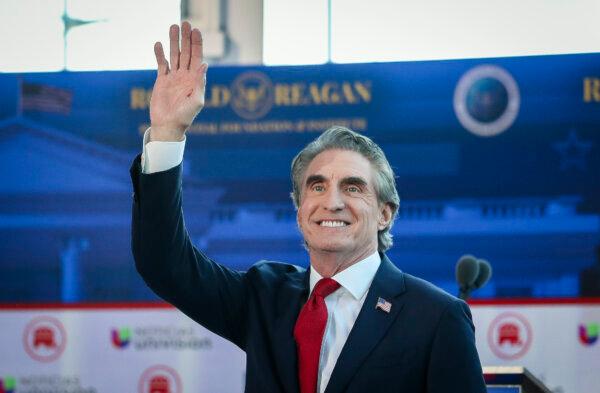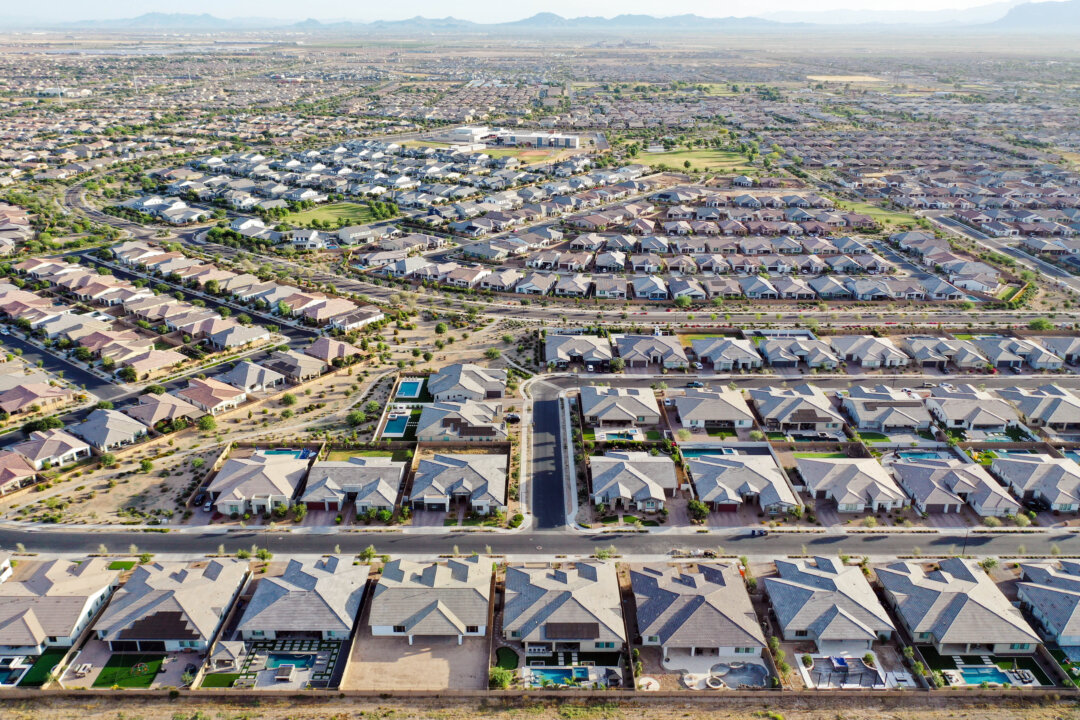The president-elect’s vision is drawing attention amid widespread concern over housing and middle-class prosperity.
On the campaign trail, President-elect Donald J. Trump outlined many big plans, from achieving energy dominance to carrying out the largest deportation operation in American history. Now, as his administration begins to take shape, enthusiasm is building for Trump’s proposed solution to the housing crisis: chartering new “Freedom Cities” using millions of acres of what is currently federal land.
“We’ll actually build new cities in our country again,” Trump said in the 2023 “Agenda 47” video announcing his plan, which hinges on a contest to create up to 10 such cities.
A year and a half later, in the lobby of a D.C. hotel, Nick Allen was enthusiastic about that vision.
“When there are new cities that are built in the U.S., new industries can form, and a new middle class can emerge,” he told The Epoch Times.
Allen, 31, is a cryptocurrency investor and the proprietor of Sovereign House, a cultural events space. While he said he has no financial stake in prospective Freedom Cities, the Frontier Foundation, of which he is a member, has become a very public booster of the idea.
Meanwhile, some early skeptics of Trump’s Freedom Cities vision are changing their tune.
In March of 2023, Jeffrey Mason of the Charter Cities Institute wrote an article for the Manhattan Institute’s City Journal casting doubt on Trump’s plan, “Freedom Cities Won’t Likely Be American.”
These days, though, Mason sounds more hopeful.
“The outsized role that the tech community is probably going to play in this administration has generally made me more optimistic about the potential for doing some version of Freedom Cities,” he told The Epoch Times.
Nolan Gray, research director of California YIMBY, noted in a recent Substack article that many others in the YIMBY (“yes-in-my-backyard”) pro-growth movement are wary of Freedom Cities. He argued that the idea is not so far-fetched as some believe.
“The federal government really does own a lot of land well-suited to housing—and is uniquely positioned to build it, given its insulation from local zoning and complaining local NIMBYs [“not-in-my-backyard”],” Gray wrote before detailing where he thinks Freedom Cities could be sited.
City Journal, the same publication in which Mason’s 2023 critique appeared, just released a pro-Freedom Cities article from Allen and his Frontier Foundation colleague, Mark Lutter.
“Freedom Cities could address two major challenges confronting the United States: a sclerotic bureaucracy and a stagnant society,” wrote Allen and Lutter, who is also executive director of the Charter Cities Institute.
‘City Air Makes You Free’
There’s a long history of cities asserting sovereignty, from the city-states of ancient Greece to the Hanseatic League of medieval northern Europe.
“All these different kinds of entities that existed exerted significant economic influence despite being relatively limited in their geographic scope,” Mason said.
But the link between urban life and freedom runs deeper, from the social organism down to the individual.
For German peasants of the Late Middle Ages, the saying “Stadtluft macht frei”—“City air makes you free”—referred to a legal way out of feudal bondage. To this day, the problems afflicting many large cities, from violent crime to unaffordable housing, exist alongside social and cultural dynamism and paths to success.

More recent models include Hong Kong, which grew rapidly during the second half of the 20th century. The dependent territory of the United Kingdom was known for its free-market orientation, earning praise from economist Milton Friedman.
Patrick Hiebert of EcoVillages said his ongoing work developing small, sustainable, liberty-minded cities in Latin America became more popular amid government responses to the COVID-19 pandemic.
“People obviously expect something else is coming,” he said in an interview with the Free Cities Foundation.
There are many other real-world examples of innovation in independent governance—some much larger in scale than tropical libertarian villages.
The Arizona retirement village Sun City, an unincorporated community of nearly 38,000 in Maricopa County, is downstream of Recreation Centers of Sun City, a nonprofit private corporation operating the community’s facilities.
The Walt Disney World Resort grew up in Florida’s Reedy Creek Improvement District, now the Central Florida Tourism Oversight District.
The 1967 act that created Disney’s special district gave the company considerable autonomy over the remote swamp land that it acquired and developed—in the words of a University of Miami Business Law Review analysis, “authority generally reserved for municipal and county governments.” That’s real sovereignty for the Magic Kingdom.
Allen points to the modern history of the Brooklyn Navy Yard. During the 1960s, New York City purchased the former naval shipbuilding facility from the federal government, converting it into an industrial park that fell under the authority of a nonprofit.
In 2021, the city created a new Brooklyn Navy Yard District with the aim of spurring new manufacturing in the Yard while promoting other uses, including the development of new public open spaces.
“This is a normal path to prosperity in a Western nation-state,” Allen said.
Brooklyn Navy Yard also provides precedent for another site that may be under consideration as a Freedom City, the former Lowry Air Force Base in Colorado.
The Trump-Vance transition team did not respond to requests for comment on the decommissioned military installation or any other Freedom City prospects.
Of course, the quest for sovereignty isn’t easy or guaranteed.
One ambitious and high-profile charter city vision, the California Forever project, has hit a snag.
A ballot measure in support of its East Solano Plan, which would develop 60,000 acres of farmland in Solano County for up to 400,000 residents, was withdrawn from the ballot ahead of November’s election.
Legislative Initiatives
Some recent legislative proposals could offer models for Freedom Cities.
One is a 2015 Texas bill that was intended to create “Liberty Cities”—a new type of municipality designed to have limited taxation, zero-based budgeting, and no zoning, among other free-market elements. The legislation would have incorporated rights to bear arms, free speech, public and private religious worship, and security from unreasonable searches and seizures into any “Liberty City.” It failed to make it out of committee.
James Quintero of the Texas Public Policy Foundation likened the Freedom Cities concept to Liberty Cities in an email to The Epoch Times.
“For Freedom Cities to truly succeed, proponents must limit federal interference that might result from coercive funding, regulatory favoritism, and corporate welfare. Government meddling is the great danger here,” he wrote.
Another likely model is the federal-level HOUSES Act, introduced by Sen. Mike Lee (R-Utah) in 2022 and again in 2023.
The bill from Lee, who has been tapped to lead the Senate’s energy and natural resources committee next year, would let state and local governments buy land from the Department of the Interior to address housing shortages. More than 70 percent of federal public lands fall under that department’s control.
Any effort to transfer Interior Department lands will likely take place under the watch of Trump’s proposed interior secretary, North Dakota Gov. Doug Burgum.

Burgum, too, has turned his attention to housing. As governor, he oversaw the creation of a new housing initiative geared toward making housing cheaper and more readily available.
Challenges on the Horizon
Even as it pushed to explore development on public land, Montana’s report emphasized that it was not recommending legislation to authorize development on state trust land. A dissenting opinion stresses that the Department of Fish and Wildlife land and other “coveted public lands” would not be targeted.
Indeed, the talk of Freedom Cities has sparked pushback over the possible sale of public lands to private parties, particularly if environmental interests are threatened.
Writer Steve Franssen described the potential future cities as “Babylonian abominations to raise GDP.”
Gray, of California YIMBY, expects more objections to materialize.
“Once specific parcels are identified, opposition will form. Once enemies, ranchers and environmentalists will lock arms, and homeowners on the periphery will defend their right to live in the last subdivision ever built,” he wrote.
Lee’s bill, the possible model for Freedom Cities, exempts federally protected land like National Monuments, National Parks, and National Wildlife Refuges.

“You wouldn’t see new suburbs pop up in Joshua Tree or the Everglades,” housing policy analyst Andrew Justus wrote in an analysis of the HOUSES Act for the centrist libertarian Niskanen Center.
Political feasibility is another sticking point. As Mason wrote in 2023, it’s hard to build new cities in the United States.
The Charter Cities Institute’s webpage touts partnerships in Africa and Latin America. The cities it cites as models of rapid, successful urban growth—Dubai, Singapore, Shenzhen, and, of course, Hong Kong—are all outside the United States and the West more generally.
“In some other countries, the Ministry of Industry or whatever comes in and says, ‘Okay, here’s a zone. It’s got these towers,’ and it’s a much simpler process. That’s just not how things are going to work here,” Allen told The Epoch Times.
There may be other philosophical conflicts even among proponents of Freedom Cities.
Texas’s Liberty Cities and other visions stress economic liberty. In an era of automation, and under the logic of the market, that might not always translate to the broad, middle-class employment that defined mid-20th century industrial hubs like Detroit.
Allen thinks new cities must go hand in hand with new jobs.
“I don’t think the new cities should be unmanned data centers for nuclear plants,” he added.

For all the possible challenges and complications, the scope of the housing crisis is starting to drive consensus and collaboration across partisan and ideological lines.
During a Dec. 12 Cato Institute event, Cato’s Chris Edwards said that “there’s been a real mind-melding” between the right and left on some aspects of housing policy, including the need for zoning reform.
This year’s YIMBYtown conference in Austin, Texas—the leftwing-yet-libertarian-inflected red state capital that Elon Musk now calls home—included presentations from both Greg Gianforte, the Republican governor of Montana, and Julián Castro, a Democrat who served as Secretary of Housing and Urban Development under former President Barack Obama.
And huge, ambitious projects have a way of drawing attention and advocates, at least at first.
“I think people do like to see big projects and new things getting built,” Mason said.

